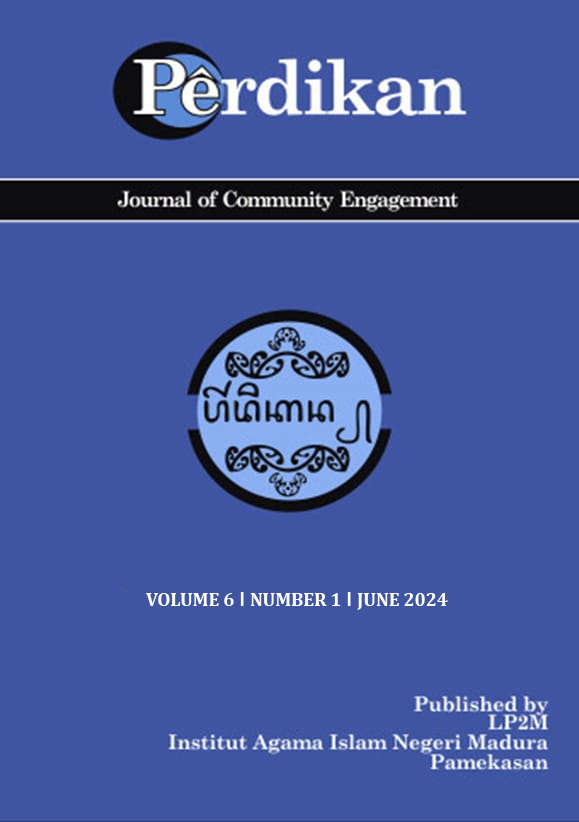Peningkatan komunitas Desa Tangguh Bencana dalam Pengurangan Risiko Bencana (PRB) kebakaran di Desa Mendahara Ilir, Kabupaten Tanjung Jabung Timur
 Abstract views: 669
,
Abstract views: 669
,
 PDF downloads: 488
PDF downloads: 488
Abstract
Mendahara Village is highly vulnerable to fire disasters. Situational analysis results show that Mendahara Village is a densely populated area, with most of the houses made of wood, a low understanding of disaster management, a lack of awareness about disaster preparedness concepts, the absence of a disaster preparedness framework, and no existing policies or regulations from the village government regarding fire disaster management. Various community service activities have enhanced public awareness of disaster consciousness, such as disaster mitigation socialization and training, disaster risk management, and the formation of Focus Group Discussions (FGDs) based on fire disaster-resilient village indicators. These activities have positively impacted increasing community awareness, knowledge, and skills in facing and managing fire disasters. This community service aims to improve public understanding of fire disaster management through education and training and the formation of FGDs based on fire disaster-resilient village indicators. The method used is active participatory partners with four stages: assessment, preparation, implementation, and evaluation. The partners in this activity are Mendahara Ilir Village. The implementation of community service enhances public understanding of the use and distribution of fire extinguishers at fire disaster risk points. The community service activities were carried out in collaboration with the East Tanjung Jabung Regency BPBD by delivering materials and conducting practical sessions. Following the community service activities, there was an average increase of 59.2% in the community's understanding of fire disaster management. The formation of FGDs involved various village community elements with tasks and objectives based on fire disaster-resilient village strategies and components. Disaster risk reduction activities must be conducted continuously to achieve a disaster-resilient village.
[Desa Mendahara memiliki kerentanan yang tinggi terhadap bencana kebakaran. Hasil analisis situasi menunjukan bahwa Desa Mendahara merupakan kawasan permukiman padat, mayoritas hunian terbuat dari kayu, pemahaman penanggulangan bencana yang masih rendah, belum memiliki pemahaman tentang konsep persiapan menghadapi bencana, belum terbangun konsep kesiapsiagaan bencana, dan belum ada kebijakan atau peraturan pemerintah desa tentang penanganan bencana kebakaran. Berbagai kegiatan pengabdian telah dilaksanakan untuk meningkatkan pemahaman masyarakat terhadap kesadaran bencana, seperti sosialisasi dan pelatihan mitigasi bencana, manajemen risiko bencana, serta pembentukan FGD berdasarkan indikator Desa Tangguh Bencana kebakaran. Kegiatan ini memberikan dampak positif terhadap peningkatan kesadaran, pengetahuan, dan keterampilan masyarakat dalam menghadapi dan menanggulangi bencana kebakaran. Kegiatan pengabdian ini bertujuan untuk meningkatkan pemahaman masyarakat dalam penanggulangan bencana kebakaran melalui pendidikan dan pelatihan, serta pembentukan FGD yang didasarkan pada indikator Desa Tangguh Bencana kebakaran. Metode yang digunakan adalah partisipatif aktif mitra dengan empat tahapan, yaitu tahap assessment, tahap persiapan, tahap implementasi, dan tahap evaluasi. Mitra dalam kegiatan ini adalah Desa Mendahara Ilir. Pelaksanaan pengabdian meningkatkan pemahaman masyarakat mengenai penggunaan dan penyebaran alat pemadam kebakaran di titik risiko bencana kebakaran. Pelaksanaan pengabdian berupa penyampaian materi dan praktik dilakukan bersama BPBD Kabupaten Tanjung Jabung Timur. Setelah pelaksanaan pengabdian, terjadi peningkatan rata-rata sebesar 59.2% terhadap pemahaman masyarakat tentang penanggulangan bencana kebakaran. Pembentukan FGD melibatkan berbagai elemen masyarakat desa yang memiliki tugas dan tujuan berdasarkan strategi dan komponen Desa Tangguh Bencana. Kegiatan pengurangan risiko bencana harus dilakukan secara berkelanjutan agar Desa Tangguh Bencana dapat tercapai.]
Downloads
References
Ambarwati, I. A. (2019). Post traumatic stress disorder: tinjauan psikologis korban kebakaran tinjauan Desa Simbur Naik Kec. Sabak Timur Kab.Tanjung Jabung Timur. JIGC (Journal of Islamic Guidance and Counseling), 3(1), 36–49. https://doi.org/10.30631/jigc.v3i1.28
Andayani, K., & Subangi, L. (2020). Tingkat kesiapan Gedung Cagar Budaya Filately dalam menghadapi bahaya kebakaran. Akselerasi : Jurnal Ilmiah Teknik Sipil, 2(1). https://doi.org/10.37058/aks.v2i1.2049
Ayuningtyas, D., Windiarti, S., Sapoan Hadi, M., Fasrini, U. U., & Barinda, S. (2021). Disaster preparedness and mitigation in Indonesia: A Narrative Review. Iranian Journal of Public Health, 50(8), 1536–1546. https://doi.org/10.18502/ijph.v50i8.6799
Delilah Roque, A., Pijawka, D., & Wutich, A. (2020). The role of social capital in resiliency: Disaster recovery in Puerto Rico. Risk, Hazards and Crisis in Public Policy, 11(2), 204–235. https://doi.org/10.1002/rhc3.12187
Gunawan, I., Afiantari, F., Kusumaningrum, D. E., Thasbikha, S. A., Zulkarnain, W., Ichwanda Burham, A. S., Nurabadi, A., Pertiwi, A. K., Andriningrum, H., Cholifah, P. S., Kusumawati, E. S., Sakinah Nuraini, N. L., & Budiarti, E. M. (2019). Improving disaster response through disaster simulation. International Journal of Innovation, Creativity and Change, 5(4), 640–653.
He, Z., & Weng, W. (2020). Synergic effects in the assessment of multi-hazard coupling disasters: Fires, explosions, and toxicant leaks. Journal of Hazardous Materials, 388(December 2019), 121813. https://doi.org/10.1016/j.jhazmat.2019.121813
Humam, A., Hidayat, M., Nurrochman, A., Anestatia, A. I., Yuliantina, A., & Aji, S. P. (2020). Identifikasi daerah kerawanan kebakaran hutan dan lahan menggunakan sistem informasi geografis dan penginderaan jauh di kawasan Tanjung Jabung Barat Provinsi Jambi. Jurnal Geosains dan Remote Sensing, 1(1), 32–42. https://doi.org/10.23960/jgrs.2020.v1i1.14
Jung, S., Woo, J., & Kang, C. (2020). Analysis of severe industrial accidents caused by hazardous chemicals in South Korea from January 2008 to June 2018. Safety Science, 124(October 2019), 104580. https://doi.org/10.1016/j.ssci.2019.104580
Khan, I., Ali, A., Waqas, T., Ullah, S., Ullah, S., Shah, A. A., & Imran, S. (2022). Investing in disaster relief and recovery: A reactive approach of disaster management in Pakistan. International Journal of Disaster Risk Reduction, 75, 102975. https://doi.org/10.1016/j.ijdrr.2022.102975
Kim, S. D., & Kim, C. S. (2019). A proposal of the disaster mitigation activity management system model for strengthening disaster prevention activities. Journal of the Society of Disaster Information, 14(4), 502–513. https://doi.org/10.15683/kosdi.2019.12.31.502
McLennan, B. J. (2020). Conditions for effective coproduction in community-led disaster risk management. Voluntas, 31(2), 316–332. https://doi.org/10.1007/s11266-018-9957-2
Monte, B. E. O., Goldenfum, J. A., Michel, G. P., & Cavalcanti, J. R. de A. (2021).Terminology of natural hazards and disasters: A review and the case of Brazil. International Journal of Disaster Risk Reduction, 52(October 2020). https://doi.org/10.1016/j.ijdrr.2020.101970
Naser, W. N., & Saleem, H. B. (2018). Emergency and disaster management training: Knowledge and attitude of Yemeni health professionals—A cross-sectional study. BMC Emergency Medicine, 18(1), 1–12. https://doi.org/10.1186/s12873-018-0174-5
Ningtyas, T., Larasati, E., Warsono, H., & Purnaweni, H. (2021). Optimization of Destana policies (Resilience Disaster Village) to Improve Community Preparedness for Flood Disaster in Bojonegoro District, Indonesia. Management and entrepreneurship: trends of development, 1(15), 113–126. https://doi.org/10.26661/2522-1566/2021-1/15-08
Oktari, R. S., Kamaruzzaman, S., Fatimahsyam, F., Sofia, S., & Sari, D. K. (2021). Gender Mainstreaming in a Disaster-Resilient Village Programme in Aceh Province, Indonesia: Towards Disaster Preparedness Enhancement via an Equal Opportunity Policy. International Journal of Disaster Risk Reduction, 52(November 2020), 101974. https://doi.org/10.1016/j.ijdrr.2020.101974
Ooi, S., Tanimoto, T., & Sano, M. (2019). Virtual Reality Fire Disaster Training System for Improving Disaster Awareness. ACM International Conference Proceeding Series, Part F1481, 301–307. https://doi.org/10.1145/3318396.3318431
Putri, A. U., Ermanovida, & Imania, K. (2023). Edukasi Masyarakat dan Penyuluhan Mitigasi Bencana Pemukiman Rawan Kebakaran di Desa Pemulutan Ilir Kecamatan Pemulutan Kabupaten Ogan Ilir. Seminar Nasional AVoER 15, 10–11.
Rimbawan, I. P. D. (2023). Tingkat Partisipatif Masyarakat dalam Kebijakan Pelaksanaan Hari Simulasi Bencana di Provinsi Bali. Journal of Scientech Research and Development, 5(2), 120–131. https://doi.org/https://doi.org/10.56670/jsrd.v5i2.171
Ritonga, A. (2024). Tinjauan Kebijakan: Evaluasi Efektivitas Upaya Penanggulangan Bencana di Desa Ciwangi. PUBLIKA : Jurnal Ilmu Administrasi Publik, 10(1), 102–127. https://doi.org/10.25299/jiap.2024.16404
Rohmadiani, L. D., & Sahliyah, M. (2023). Kerentanan Permukiman Kumuh Kelurahan Krian terhadap Bencana Kebakaran. COMPACT: Spatial Development Journal, 2(1), 113–127. https://doi.org/10.35718/compact.v2i1.824
Rosselló, J., Becken, S., & Santana-Gallego, M. (2020). The Effects of Natural Disasters on International Tourism: A Global Analysis. Tourism Management, 79(April 2019). https://doi.org/10.1016/j.tourman.2020.104080
Ryan, B., Johnston, K. A., Taylor, M., & McAndrew, R. (2020). Community Engagement for Disaster Preparedness: A Systematic Literature Review. International Journal of Disaster Risk Reduction, 49(May), 101655. https://doi.org/10.1016/j.ijdrr.2020.101655
Saharjo, B. H., & Efendi, D. A. (2023). Kebakaran Hutan dan Lahan Gambut di Kabupaten Tanjung Jabung Timur, Provinsi Jambi. Jurnal Silvikultur Tropika, 14(02), 126–131. https://doi.org/https://doi.org/10.29244/j-siltrop.14.02.126-131
Sunarto, Suparji, Suharto, A., Fernanda, A. R., & Zakinah, N. (2023). Pemanfaatan Metode Participatory Rural Appraisal untuk Kesiapsiagaan Kapasitas Desa Tangguh Bencana dalam Pengurangan Risiko Bencana di Desa Jajar Kartoharjo dan Desa Genilangit Poncol Magetan. Jurnal Abdi Masyarakat Indonesia, 3(2), 571–582. https://doi.org/10.54082/jamsi.483
Supratiwi, Yuwanto, & Kushandajani. (2022). Community Participation in Disaster Management in Gondoriyo Village Administration, Ngaliyan Sub-District, Semarang city. IOP Conference Series: Earth and Environmental Science, 1041(1). https://doi.org/10.1088/1755-1315/1041/1/012032
Triastari, I., Dwiningrum, S. I. A., & Rahmia, S. H. (2021). Developing Disaster Mitigation Education with Local Wisdom: Exemplified in Indonesia Schools. IOP Conference Series: Earth and Environmental Science, 884(1). https://doi.org/10.1088/1755-1315/884/1/012004
Villeneuve, M., Abson, L., Pertiwi, P., & Moss, M. (2021). Applying a Person-Centred Capability Framework to Inform Targeted Action on Disability Inclusive Disaster Risk Reduction. International Journal of Disaster Risk Reduction, 52, 101979. https://doi.org/10.1016/j.ijdrr.2020.101979
Wulandari, R. (2017). Analisis Kesiapan Pemerintah Daerah dalam Penanganan Penyandang Disabilitas Menghadapi Bencana Gempa Bumi. Jurnal Prodi Manajemen Bencana, 3(1), 23–41.
Zam, B. M. I. A. Z., Harnanto, A. M., Widodo, W., Sunarto, S., & Sumardino, S. (2022). Improved Fire Disaster Mitigation Efforts through Nursing Disaster Education among a Boarding School Students and Teachers at Surakarta City. Basic and Applied Nursing Research Journal, 3(1), 19–23. https://doi.org/10.11594/banrj.03.01.04
Zamil, A. A. H., Nurita, T., Fitriani, N. I., & Presidena, P. (2019). Kajian Literatur Berbasis Sistem Peringatan Dini Mitigasi Bencana Gunung Meletus. Jurnal Multidisiplin Saintek, 3(2), 5–24. https://doi.org/https://doi.org/10.3785/kohesi.v3i2.2940
Zein, M. H. M., & Septiani, S. (2021). Evaluasi Pelayanan Penanggulangan Bencana Kebakaran oleh Pemerintah Kecamatan. Journal of Administrative and Social Science, 2(2), 50–60. https://doi.org/10.55606/jass.v2i2.1021
Copyright (c) 2024 PERDIKAN (Journal of Community Engagement)

This work is licensed under a Creative Commons Attribution-NonCommercial 4.0 International License.
In order for PERDIKAN to publish and disseminate research articles, we need publishing rights. This is determined by a publishing agreement between the author and PERDIKAN. This agreement deals with the transfer or license of the copyright to PERDIKAN and authors retain significant rights to use and share their own published articles. For both subscription and open access articles, published in proprietary titles, PERDIKAN is granted the following rights:
- The right to provide the article in all forms and media so the article can be used on the latest technology even after publication.
- The authority to enforce the rights in the article, on behalf of an author, against third parties, for example in the case of plagiarism or copyright infringement.
Copyright aims to protect the specific way the article has been written to describe an experiment and the results. PERDIKAN is committed to its authors to protect and defend their work and their reputation and takes allegations of infringement, plagiarism, ethic disputes and fraud very seriously.
If an author becomes aware of a possible plagiarism, fraud or infringement we recommend contacting their PERDIKAN publishing contact who can then liaise with our in-house legal department. Note that certain open access user licenses may permit



1.png)


1.png)


